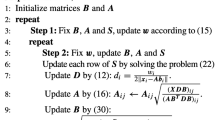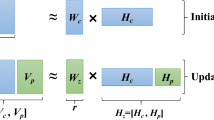Abstract
Matrix factorization is widely used in recommendation systems, text mining, face recognition and computer vision. As one of the most popular methods, nonnegative matrix factorization and its incremental variants have attracted much attention. The existing incremental algorithms are established based on the assumption of samples are independent and only update the new latent variable of weighting coefficient matrix when the new sample comes, which may lead to inferior solutions. To address this issue, we investigate a novel incremental nonnegative matrix factorization algorithm based on correlation and graph regularizer (ICGNMF). The correlation is mainly used for finding out those correlated rows to be updated, that is, we assume that samples are dependent on each other. We derive the updating rules for ICGNMF by considering the correlation. We also present tests on widely used image datasets, and show ICGNMF reduces the error by comparing other methods.



Similar content being viewed by others
Explore related subjects
Discover the latest articles, news and stories from top researchers in related subjects.Notes
The FERET can be found at http://www.itl.nist.gov/iad/humanid/feret/feret-master.html.
The Pets can be found at http://ftp.pets.rdg.ac.uk.
References
Lee J, Kim S, Lebanon G, Singer Y, Bengio S (2016) LLORMA: local low-rank matrix approximation. J Mach Learn Res 17(15):1–24
Hernando A, Bobadilla J, Ortega F (2016) A non negative matrix factorization for collaborative filtering recommender systems based on a Bayesian probabilistic model. Knowl Based Syst 97:188–202
Lee D, Seung H (1999) Learning the parts of objects by non-negative matrix factorization. Nature 401(6755):788–791
Paatero P, Tapper U (1994) Positive matrix factorization: a non-negative factor model with optimal utilization of error estimates of data values. Environmetrics 5(2):111–126
Guillamet D, Vitria J (2002) Non-negative matrix factorization for face recognition. In: Escrig MT, Toledo F, Golobardes E (eds) Topics in Artificial Intelligence. Lecture notes in computer science, vol 2504. Springer, Berlin, Heidelberg, pp 336–344
Fogel P, Young S, Hawkins D, Ledirac N (2007) Inferential, robust non-negative matrix factorization analysis of microarray data. Bioinformatics 23(1):44–49
Chen Y, Bhojanapalli S, Sanghavi S et al (2015) Completing any low-rank matrix, provably. J Mach Learn Res 16:2999–3034
Wang R, Shan S, Chen X, Gao W (2008) Manifold–manifold distance with application to face recognition based on image set. In: IEEE conference on computer vision and pattern recognition. Anchorage, Alaska, pp 1–8
Cai D, He X, Han J, Huang T (2011) Graph regularized nonnegative matrix factorization for data representation. IEEE Trans Pattern Anal Mach Intell 33(8):1548–1560
Ding C, Li T, Jordan M (2010) Convex and semi-nonnegative matrix factorizations. IEEE Trans Pattern Anal Mach Intell 32(1):45–55
Guan N, Tao D, Luo Z, Yuan B (2012) Online nonnegative matrix factorization with robust stochastic approximation. IEEE Trans Neural Netw Learn Syst 23(7):1087–1099
Gopalan P, Hofman J, Blei D (2013) Scalable recommendation with Poisson factorization. arXiv:1311.1704
Hastie T, Mazumder R, Lee J, Zadeh R (2015) Matrix completion and low-rank svd via fast alternating least squares. J Mach Learn Res 16(1):3367–3402
Luo X, Zhou M, Xia Y, Zhu Q (2014) An efficient non-negative matrix-factorization-based approach to collaborative filtering for recommender systems. IEEE Trans Ind Inf 10(2):1273–1284
Wu J, Chen L, Feng Y et al (2013) Predicting quality of service for selection by neighborhood-based collaborative filtering. IEEE Trans Syst Man Cybern Syst 43(2):428–439
Li S, Hou X, Zhang H, Cheng Q (2001) Learning spatially localized, parts-based representation. IEEE Comput Soc Conf Comput Vis Pattern Recognit 1:1–6
Xu W, Liu X, Gong Y (2003) Document clustering based on non-negative matrix factorization. In: International ACM SIGIR conference on Research and development in information retrieval. Toronto, pp 267–273
Bucak S, Gunsel B (2009) Incremental subspace learning via non-negative matrix factorization. Pattern Recognit 42(5):788–797
Yu Z, Liu Y, Li B et al (2014) Incremental graph regulated nonnegative matrix factorization for face recognition. J Appl Math 2014(1):1–10
Wang F, Li P, Konig AC (2011) Efficient document clustering via online nonnegative matrix factorizations. In: Eleventh Siam international conference on data mining, Arizona, pp 908–919
Lefèvre A, Bach F, Févotte C (2011) Online algorithms for nonnegative matrix factorization with the Itakura-Saito divergence. In Proceedings of IEEE workshop on applications of signal processing to audio and acoustics, vol 53. pp 313–316
Zhou G, Yang Z, Xie S, Yang J (2011) Online blind source separation using incremental nonnegative matrix factorization with volume constraint. IEEE Trans Neural Netw 22(4):550–60
Chen W, Pan B, Fang B et al (2008) Incremental nonnegative matrix factorization for face recognition. Math Prob Eng 2008:1–17
Tenenbaum J, De Silva V, Langford J (2000) A global geometric framework for nonlinear dimensionality reduction. Science 290(5500):2319–2323
Roweis S, Saul L (2000) Nonlinear dimensionality reduction by locally linear embedding. Science 290(5500):2323–2326
Mao Y, Saul L (2004) Modeling distances in large-scale networks by matrix factorization. In: Proceedings of the 4th ACM SIGCOMM conference on internet measurement. Taormina, Sicily, pp 278–287
Chung F (1997) Spectral graph theory. CBMS Regional Conference Series in Mathematics, 92. American Mathematical Society, Providence, RI
Cai D, He X, Hu Y et al (2007) Learning a spatially smooth subspace for face recognition. In: IEEE conference on computer vision and pattern recognition. IEEE, pp 1–7
Acknowledgements
This work is supported in part by the National Natural Science Fund of China (71471060), the Fundamental Research Funds for the Central Universities Support Program (2015xs71), the China Scholarship Council and the National Energy Research Scientific Computing Center (NERSC).
Author information
Authors and Affiliations
Corresponding author
Rights and permissions
About this article
Cite this article
Zhang, X., Chen, D. & Wu, K. Incremental nonnegative matrix factorization based on correlation and graph regularization for matrix completion. Int. J. Mach. Learn. & Cyber. 10, 1259–1268 (2019). https://doi.org/10.1007/s13042-018-0808-7
Received:
Accepted:
Published:
Issue Date:
DOI: https://doi.org/10.1007/s13042-018-0808-7




